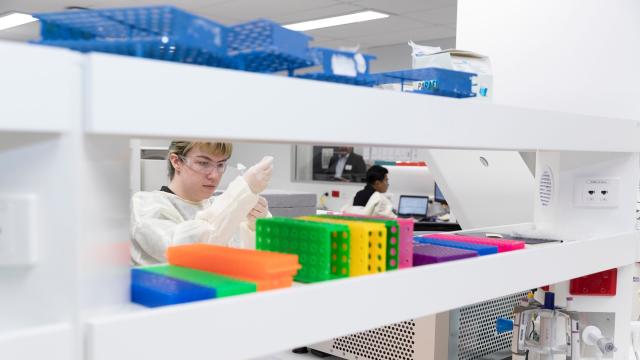Pfizer and BioNTech announced today that their vaccine candidate appears to be 90 per cent effective at preventing COVID-19 in the volunteers in their study. It’s encouraging, but there’s still a long way to go between this and an actually effective, available vaccine.
Which vaccine candidate is this?
Pfizer’s vaccine is one of four currently going through trials in the United States. Two of the vaccine candidates, including Pfizer’s, use mRNA instead of proteins or whole viruses. This is a new type of vaccine, one that has never been approved before.
It also requires ultra-cold storage rather than being stored in standard refrigerators or freezers. That poses a logistical issue, but it may be solvable by innovations like shipping the vaccine in special coolers.
The vaccine calls for two doses, given three weeks apart.
What we know so far
The current results are from a Phase 3 trial, the last stage of testing before a vaccine can potentially be approved or given an emergency use authorisation. The trial isn’t yet finished; this is an interim analysis.
The results haven’t been peer-reviewed, and even Pfizer’s scientists don’t have access to the full data. (An independent review board told them the partial results, which is a safeguard to prevent the possibility of the company changing their actions or interpretation mid-trial.)
In their announcement, and in speaking with reporters, they have told us:
- 94 people in the trial had cases of COVID-19, mostly in the control arm
- The vaccine appears to be 90% effective
- The trial will continue until 164 total cases have been counted
- They may have enough data to apply for an emergency use authorisation later in November.
According to previous studies, side effects of the vaccine seem to include fever, chills and body aches. STAT reports that the side effects are likely to be similar to other adult vaccines, but possibly a bit worse than what we experience from a flu shot.
What we still don’t know
We don’t know if the effectiveness will still be 90% by the time the trial ends. If so, or if it’s anywhere close, that’s a huge success. Regulators have been hoping for anything above 50%.
We don’t know how well the vaccine works at preventing severe cases of COVID-19, only that it seems to preventing cases in general. (It’s likely that a vaccine that prevents cases is going to prevent severe cases or will make them less severe, as with the flu shot, but we won’t know until we have the data.)
We also don’t know if the vaccine prevents infections, as distinct from cases. If you get the coronavirus, you have an infection and can probably transmit the disease even if you never experience symptoms. A vaccine that prevents infections can stop the spread of the virus; a vaccine that only prevents infections from advancing into disease may not do much to slow the spread, only limit its effects.
We don’t have much information yet about side effects, including potentially serious ones.
We do not know how long protection will last. A few months? A few years? There’s no way to answer that question with just a few months’ data.
The study populations were not representative of the whole U.S., although they did say 42% of total participants had “diverse backgrounds.”
We don’t know how well the vaccine will work in children; nobody under age 12 was enrolled in the trials.
The study protocol, described in this Pfizer document, also excluded anybody who had a serious health condition, who had previously contracted COVID-19, or was pregnant or breastfeeding. That’s a lot of high-risk people who weren’t part of the study, but who need protection from the coronavirus. Pregnant women are more likely than their non-pregnant peers to experience severe COVID-19.
What’s next
Pfizer says they plan to ask the FDA for an emergency use authorisation later this month, once they’ve met the requirement that at least half the participants must have been followed for at least two months after their last dose.
Pfizer’s vaccine candidate is one of several, and there’s no guarantee that it will be the first or the only one to eventually make it to market. It’s very possible that, next year, we may need to choose between four or five different vaccines. Some may work better than others.
It takes time to manufacture doses of vaccine, and regulators say the plan for any vaccine is to make it available first to people who are at high risk, although there’s not yet a clear plan for who those first recipients will be. The most optimistic timeline holds that a vaccine — maybe this one, maybe another — could be available as early as January 2021.

Leave a Reply
You must be logged in to post a comment.